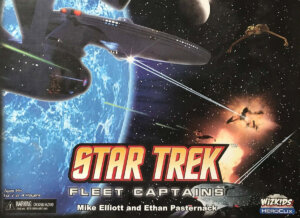
Publisher: WizKids
Designers: Mike Elliott, Bryan Kinsella, Ethan Pasternack
Year: 2011
Genre: Star Trek game of exploration and combat
Players: Two or four players
Ages: 14+
Playing Time: 60-90 Minutes
MSRP: $79.99
I received my copy of Star Trek: Fleet Captains on my birthday. I’ll admit my eyes were shining with excitement as I tore open the package to see the U.S.S Enterprise blasting away at a Klingon Bird of Prey on the cover of the box. I am a huge Star Trek fan, and have been since I was in diapers. I stood in line with tears in my eyes while I was waiting to see Star Trek: The Motion Picture. The movie kind of sucked, but for those who had been waiting for so many years to see your heroes reunited again, that didn’t matter.
Many years, Trek movies, and TV shows have passed since then; some good, some not so good. I still love to see the legacy continue on to new generations, so I was happy to get a chance to try this new way of exploring the final frontier.
When you pull the cover off of the box, the first thing you notice is the smell of chemical plastic which can mean component bliss to some and nausea to others. I was not disappointed. I was greeted with a plethora of cards, tokens, and the ships. There are 24 of them each pressed into their own individual molded space in the box to hold them in place firmly, along with a piece of foam to cover them and protect them. The ships are nice, mounted on clear plastic stands, on top of black Heroclix bases. None of the ships were broken and all of the bases clicked with no problem. The cards are thinner than I am used to but still of good quality and silk screened. The location tiles are of the same material, I would have preferred thicker tiles as these won’t lay completely flat, but they work and are easy to shuffle.
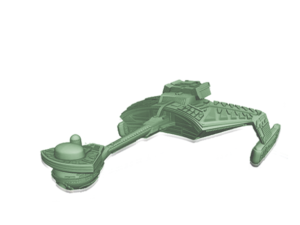
Speaking of fleets, each ship has a cards associated with it. The cards have the values of the Heroclix dials on them including settings for weapons, shields, sensors, and engines. There are three levels within these settings one each for normal, yellow alert and red alert. If your ship takes a point of damage you must click the dial over to the yellow alert section. You are restricted to the settings in this section while the ship has one point of damage. Another point of damage will bring you to red alert status, and a third point destroys the ship. The cards also list a size for the ship and this is what is used to build your fleet. The players choose a fleet size for the game. Normally this is ten points but you can adjust for a shorter or longer game. The players start flipping over ship cards and adding up the size points until they reach the correct total exactly. You may need to go through the deck more than once, but eventually all the players end up with random fleets adding up to a uniform size.
At this point you’ll be selecting your command cards. Each side has ten separate stacks of ten cards each themed around some aspect of Trek or mission types. You see, you’ll be selecting a stack of ten mission cards. The missions are separated into combat, influence, and science missions. Each ship lists the types of missions they are used for and you draw mission cards from the appropriate stacks. You don’t know what the missions are but you know what they will basically involve. Then you select four stacks of command cards that are geared towards the types of missions that you will be facing. Examples are the Captain Kirk deck, or the main Engineering Deck. You shuffle together these cards to form your command deck, which you will draw and play from during the game.
Finally you are ready to play. Flip over three of the mission cards. If it is a secret mission make sure to read it and flip it back face down so your opponent can’t see it. On your turn you can move all you your ships up to their engine power value. Each location tile in space has a size value that indicates how many movement points it will take to cross it. To move to an adjacent tile is only one movement point. If it is unexplored you must flip it over to see what is there. You might find a quasar, or nebula, a habitable planet, or a dreaded black hole among other things. There is an encounter value on each tile and you have to roll a die to see if you have an encounter. If you do, you draw an encounter card and resolve it. Sometimes they are good and sometimes not. There are even some that will provide a victory point for you if resolved. I should mention that the object of the game is to score a certain number of victory points by completing missions. The amount is determined by the size of the fleet you started the game with. So in a standard ten point fleet sized game, you’ll need to get ten victory points.
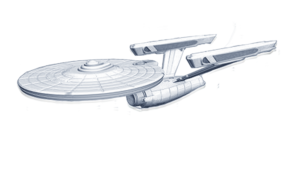
There are a lot of other things you can do on your turn. You can play command cards, or perform a test. This is how you accomplish many of your missions and is in effect a skill check using a value from one of your ship’s systems, plus a die roll to meet or beat a certain number, like a level 20 sensor check for example. You can also perform three actions from a big list of actions. These include attacking another ship, exerting influence in a location, building an installation on a habitable planet, engaging a clocking device, creating a sensor echo to hide from your enemies, repairing a damaged ship, calling up reinforcements, sending off an away team, adding a crew member to a ship, and so on.
Adding a crew member is really cool, because some of your command cards are characters from the various Star Trek TV series that can be permanently attached to a ship and can provide some excellent bonuses. The ships themselves all have special abilities too.
Combat is simple. It is just a skill check with the attacker’s weapon value vs. the defender’s shield value. Each player can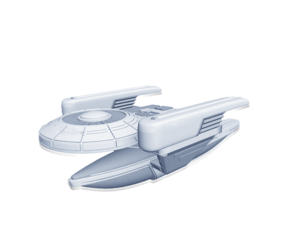
There are those who will not like the randomness of the fleets and the location tiles. In fact, in one game I was faced with empty space and black holes surrounding my command post, while my opponent had a habitable planet on the first tile he landed on.
This is one of those games that leave you with a story. There is a lot that can happen, strategies you can try, and encounters that you must face. I loved this game, even when the fates turn against me it was still a great time. It has a great replayability value with all of the different ships and cards and encounters and locations. The rulebook has many examples and is an easy read; it just isn’t laid out very well and could have benefited from a player summary aid. There is one of a sort on the back of the rulebook, but you’ll be referring to the rulebook a lot in your first few games and won’t really have time to watch the back of the rulebook.
I would love to see a Romulan expansion, which would add the ability to play with three players. A Borg expansion would be great too and could make an excellent solitaire game. There are so many possibilities and I’m really hoping that WizKids continues this line. It is a very good game.
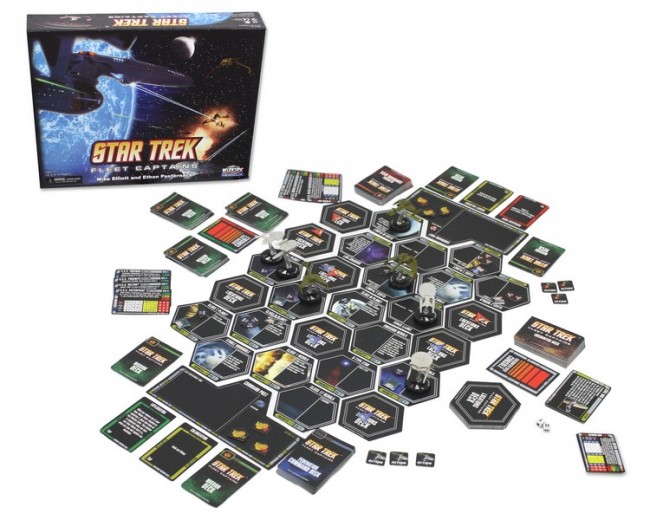
[rwp-review id=”0″]
- A Dungeon Delve for Kids?: A Review of Dungeon! - Oct 24, 2022
- Better, Stronger, Faster | Descent: Journeys in the Dark Second Edition Reviewed - Oct 23, 2022
- Your Planet is Doomed!: Invasion from Outer Space Reviewed - Oct 22, 2022

















